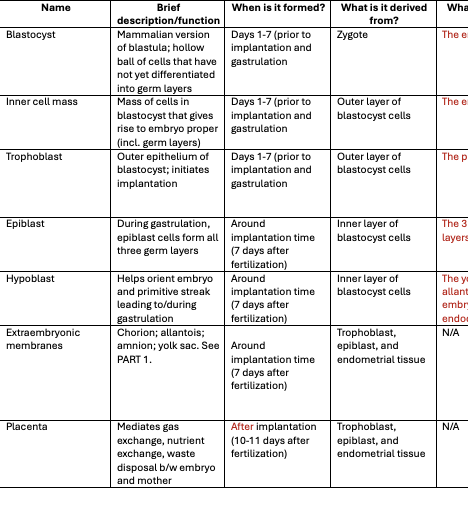Name Brief description/function When is it formed? What is it derived from? What does it give rise to? Additional notes Blastocyst Mammalian version o
Name | Brief description/function | When is it formed? | What is it derived from? | What does it give rise to? | Additional notes |
Blastocyst | Mammalian version of blastula; hollow ball of cells that have not yet differentiated into germ layers | Days 1-7 (prior to implantation and gastrulation | Zygote | The embryo | Helps develop trophoblast layer |
Inner cell mass | Mass of cells in blastocyst that gives rise to embryo proper (incl. germ layers) | Days 1-7 (prior to implantation and gastrulation | Outer layer of blastocyst cells | The embryo |
|
Trophoblast | Outer epithelium of blastocyst; initiates implantation | Days 1-7 (prior to implantation and gastrulation | Outer layer of blastocyst cells | The placenta | Breaks down endometrium to allow for implantation forms placenta |
Epiblast | During gastrulation, epiblast cells form all three germ layers | Around implantation time (7 days after fertilization) | Inner layer of blastocyst cells | The 3 primary germ layers
|
|
Hypoblast | Helps orient embryo and primitive streak leading to/during gastrulation | Around implantation time (7 days after fertilization) | Inner layer of blastocyst cells | The yolk sac, the allantois, and the embryonic endoderm |
|
Extraembryonic membranes | Chorion; allantois; amnion; yolk sac. See PART 1. |
Around implantation time (7 days after fertilization)
| Trophoblast, epiblast, and endometrial tissue | N/A | Form the ‘life support’ system of the embryo |
Placenta | Mediates gas exchange, nutrient exchange, waste disposal b/w embryo and mother | After implantation (10-11 days after fertilization) | Trophoblast, epiblast, and endometrial tissue | N/A | Gas exchange and provides nutrients  |